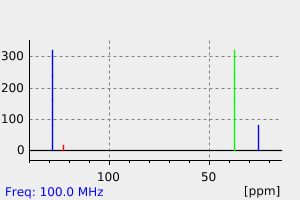环戊-3-烯-1-甲腈 | 4492-41-5
中文名称
环戊-3-烯-1-甲腈
中文别名
——
英文名称
cyclopent-3-ene-1-carbonitrile
英文别名
4-cyanocyclopentene;1-Cyan-cyclopenten-(3);4-Cyano-cyclopenten;4-Cyan-cyclopenten
CAS
4492-41-5
化学式
C6H7N
mdl
——
分子量
93.1283
InChiKey
JCHHHZHRUTYDLD-UHFFFAOYSA-N
BEILSTEIN
——
EINECS
——
-
物化性质
-
计算性质
-
ADMET
-
安全信息
-
SDS
-
制备方法与用途
-
上下游信息
-
文献信息
-
表征谱图
-
同类化合物
-
相关功能分类
-
相关结构分类
计算性质
-
辛醇/水分配系数(LogP):1.1
-
重原子数:7
-
可旋转键数:0
-
环数:1.0
-
sp3杂化的碳原子比例:0.5
-
拓扑面积:23.8
-
氢给体数:0
-
氢受体数:1
上下游信息
-
上游原料
中文名称 英文名称 CAS号 化学式 分子量 —— 2-allylpent-4-enenitrile 75265-83-7 C8H11N 121.182
反应信息
-
作为反应物:描述:环戊-3-烯-1-甲腈 在 盐酸 、 四(三苯基膦)钯 、 正丁基锂 、 硫酸 、 四丁基溴化铵 、 sodium carbonate 、 potassium carbonate 、 溶剂黄146 作用下, 以 四氢呋喃 、 1,4-二氧六环 、 乙醇 、 水 、 甲苯 为溶剂, 反应 50.0h, 生成 (S)-1-((6-(3-(difluoromethoxy)-5-fluorophenyl)-4-((3-(trifluoromethyl)phenyl)sulfonyl)-3,4-dihydro-2H-benzo[b][1,4]oxazin-2-yl)methyl)cyclopent-3-ene-1-carboxylic acid参考文献:名称:[EN] ARYL DIHYDRO-2H-BENZO[B][1,4]OXAZINE SULFONAMIDE AND RELATED COMPOUNDS FOR USE AS AGONISTS OF RORY AND THE TREATMENT OF DISEASE
[FR] ARYL DIHYDRO-2H-BENZO[B][1,4]OXAZINE SULFONAMIDE ET COMPOSÉS APPARENTÉS DESTINÉS À ÊTRE UTILISÉS COMME AGONISTES DE RORΓ ET POUR LE TRAITEMENT DE MALADIES摘要:这项发明提供了芳基二氢-2H-苯并[b][1,4]噁嗪磺胺和相关化合物、药物组合物、促进RORγ活性的方法、增加受试者体内IL-17含量的方法,以及利用这些化合物治疗癌症和其他医学疾病的方法。公开号:WO2016201225A1 -
作为产物:参考文献:名称:Descotes,G.; Robbe,P., Bulletin de la Societe Chimique de France, 1969, p. 1349 - 1355摘要:DOI:
文献信息
-
Scope and Mechanism of Intramolecular Aziridination of Cyclopent-3-enyl-methylamines to 1-Azatricyclo[2.2.1.0<sup>2,6</sup>]heptanes with Lead Tetraacetate作者:Huayou Hu、Juan A. Faraldos、Robert M. CoatesDOI:10.1021/ja9044136日期:2009.8.26cyclopent-3-en-1-ylmethylamines bearing one, two, or three methyl substituents at the C2, C3, C4, or C(alpha) positions, including the unsubstituted parent, was accessed by ring-closing metatheses of alpha,alpha-diallylacetonitrile (or methallyl variants) and alpha,alpha-diallylacetone followed by hydride reductions or reductive amination, or by Curtius degradations of alpha,alpha-dimethyl- and 2,2,3在 C2、C3、C4 或 C(α) 位置带有一个、两个或三个甲基取代基的一系列七个环戊-3-烯-1-基甲胺,包括未取代的母体,通过闭环复分解获得α,α-二烯丙基乙腈(或甲代烯丙基变体)和 α,α-二烯丙基丙酮,然后进行氢化物还原或还原胺化,或通过 α,α-二甲基-和 2,2,3-三甲基环戊-3-烯基乙酸的 Curtius 降解。在存在 K(2)CO(3) 的情况下,在 CH(2)Cl(2)、CHCl(3) 或苯中用 Pb(OAc)(4) 氧化伯胺可实现有效的分子内氮丙啶化,在所有情况下,除了α-甲基类似物 (16),形成相应的 1-氮杂三环 [2.2.1.0(2,6)] 庚烷,包括新型单萜类似物、1-氮杂三环烯和 2-氮杂三环烯对映体。与未取代的母体胺的速率 (1:17.5) 相比,由于环戊烯双键上存在一个或两个甲基,在 CDCl(3) 中通过 (1) H NMR 光谱观察到的氮丙啶化反应
-
Construction of oxygenated 2-azabicyclo[2.2.1]heptanes <i>via</i> palladium-catalyzed 1,2-aminoacyloxylation of cyclopentenes作者:Haipin Zhou、Rui Pan、Menghua Xu、Jiao Ma、Aijun Lin、Hequan YaoDOI:10.1039/d2cc06581a日期:——Herein, we describe a palladium-catalyzed 1,2-aminoacyloxylation of cyclopentenes to synthesize oxygenated 2-azabicyclo[2.2.1]heptanes. This reaction proceeds efficiently with a broad array of substrates. The products could be further functionalized to build up a library of bridged aza-bicyclic structures.
-
Two-Carbon Elongation/Annulation of Alcohols to Nitriles作者:J LaiDOI:10.1016/00404-0399(50)11252-日期:1995.8.7
-
Chemistry of sulfoxides and related compounds. XIII. Synthesis of 2-thiabicyclo[2.2.1]heptane derivatives作者:Carl Randolph Johnson、Jeffrey E. Keiser、John C. SharpDOI:10.1021/jo01256a018日期:1969.4
-
Preparation and characterization of 2-silanorbornanes作者:Sheldon E. Cremer、Craig BlankenshipDOI:10.1021/jo00348a004日期:1982.4
表征谱图
-
氢谱1HNMR
-
质谱MS
-
碳谱13CNMR
-
红外IR
-
拉曼Raman
-
峰位数据
-
峰位匹配
-
表征信息
同类化合物
(乙腈)二氯镍(II)
(R)-(-)-α-甲基组胺二氢溴化物
(N-(2-甲基丙-2-烯-1-基)乙烷-1,2-二胺)
(4-(苄氧基)-2-(哌啶-1-基)吡啶咪丁-5-基)硼酸
(11-巯基十一烷基)-,,-三甲基溴化铵
鼠立死
鹿花菌素
鲸蜡醇硫酸酯DEA盐
鲸蜡硬脂基二甲基氯化铵
鲸蜡基胺氢氟酸盐
鲸蜡基二甲胺盐酸盐
高苯丙氨醇
高箱鲀毒素
高氯酸5-(二甲氨基)-1-({(E)-[4-(二甲氨基)苯基]甲亚基}氨基)-2-甲基吡啶正离子
高氯酸2-氯-1-({(E)-[4-(二甲氨基)苯基]甲亚基}氨基)-6-甲基吡啶正离子
高氯酸2-(丙烯酰基氧基)-N,N,N-三甲基乙铵
马诺地尔
马来酸氢十八烷酯
马来酸噻吗洛尔EP杂质C
马来酸噻吗洛尔
马来酸倍他司汀
顺式环己烷-1,3-二胺盐酸盐
顺式氯化锆二乙腈
顺式吡咯烷-3,4-二醇盐酸盐
顺式双(3-甲氧基丙腈)二氯铂(II)
顺式3,4-二氟吡咯烷盐酸盐
顺式1-甲基环丙烷1,2-二腈
顺式-二氯-反式-二乙酸-氨-环己胺合铂
顺式-二抗坏血酸(外消旋-1,2-二氨基环己烷)铂(II)水合物
顺式-N,2-二甲基环己胺
顺式-4-甲氧基-环己胺盐酸盐
顺式-4-环己烯-1.2-二胺
顺式-4-氨基-2,2,2-三氟乙酸环己酯
顺式-3-氨基环丁烷甲腈盐酸盐
顺式-2-羟基甲基-1-甲基-1-环己胺
顺式-2-甲基环己胺
顺式-2-(苯基氨基)环己醇
顺式-2-(苯基氨基)环己醇
顺式-2-(氨基甲基)-1-苯基环丙烷羧酸盐酸盐
顺式-1,3-二氨基环戊烷
顺式-1,2-环戊烷二胺二盐酸盐
顺式-1,2-环戊烷二胺
顺式-1,2-环丁腈
顺式-1,2-双氨甲基环己烷
顺式--N,N'-二甲基-1,2-环己二胺
顺式-(R,S)-1,2-二氨基环己烷铂硫酸盐
顺式-(2-氨基-环戊基)-甲醇
顺-2-戊烯腈
顺-1,3-环己烷二胺
顺-1,3-双(氨甲基)环己烷







